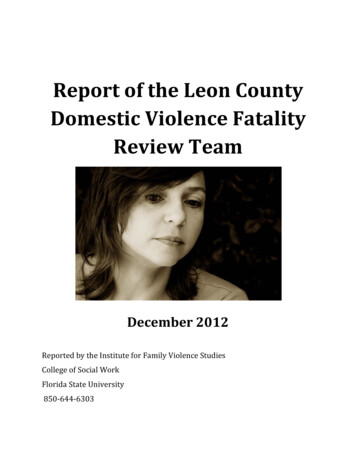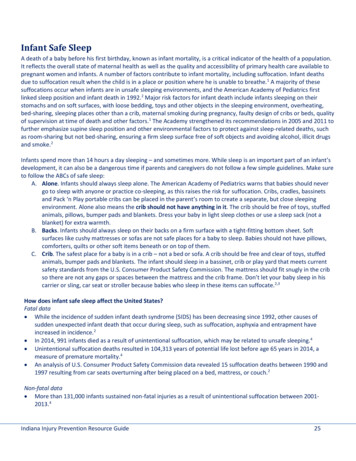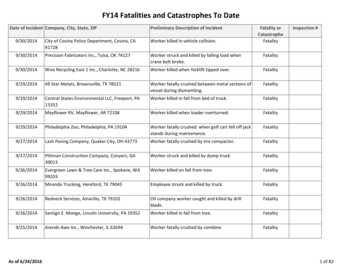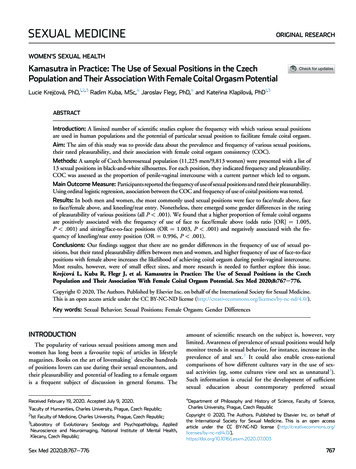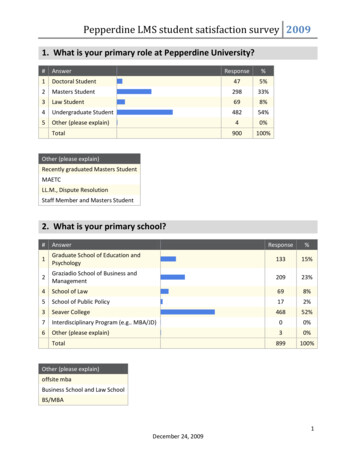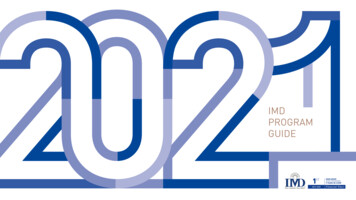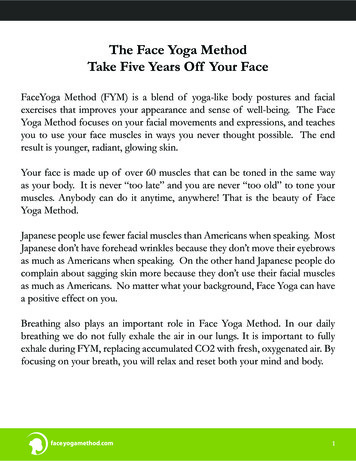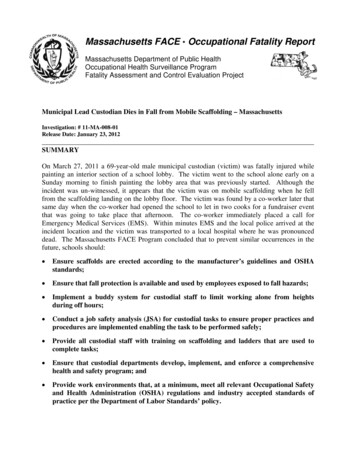
Transcription
Massachusetts FACE Occupational Fatality ReportMassachusetts Department of Public HealthOccupational Health Surveillance ProgramFatality Assessment and Control Evaluation ProjectMunicipal Lead Custodian Dies in Fall from Mobile Scaffolding – MassachusettsInvestigation: # 11-MA-008-01Release Date: January 23, 2012SUMMARYOn March 27, 2011 a 69-year-old male municipal custodian (victim) was fatally injured whilepainting an interior section of a school lobby. The victim went to the school alone early on aSunday morning to finish painting the lobby area that was previously started. Although theincident was un-witnessed, it appears that the victim was on mobile scaffolding when he fellfrom the scaffolding landing on the lobby floor. The victim was found by a co-worker later thatsame day when the co-worker had opened the school to let in two cooks for a fundraiser eventthat was going to take place that afternoon. The co-worker immediately placed a call forEmergency Medical Services (EMS). Within minutes EMS and the local police arrived at theincident location and the victim was transported to a local hospital where he was pronounceddead. The Massachusetts FACE Program concluded that to prevent similar occurrences in thefuture, schools should: Ensure scaffolds are erected according to the manufacturer’s guidelines and OSHAstandards; Ensure that fall protection is available and used by employees exposed to fall hazards; Implement a buddy system for custodial staff to limit working alone from heightsduring off hours; Conduct a job safety analysis (JSA) for custodial tasks to ensure proper practices andprocedures are implemented enabling the task to be performed safely; Provide all custodial staff with training on scaffolding and ladders that are used tocomplete tasks; Ensure that custodial departments develop, implement, and enforce a comprehensivehealth and safety program; and Provide work environments that, at a minimum, meet all relevant Occupational Safetyand Health Administration (OSHA) regulations and industry accepted standards ofpractice per the Department of Labor Standards’ policy.
11MA008Page 2INTRODUCTIONOn March 27, 2011, the Massachusetts FACE Program was notified by a local police departmentthrough the 24-hour Occupational Fatality Hotline that on the same day a 69-year-old maleschool custodian had died from injuries sustained when he fell from scaffolding. Aninvestigation was initiated. On April 14, 2011, the Massachusetts FACE Program Director and arepresentative from the Massachusetts Department of Labor Standards (DLS) traveled to theschool superintendent’s office, the incident location, and to the police/fire departments and metwith representatives at each location to discuss the incident. The police report and deathcertificate were reviewed during the course of the investigation. Photographs were taken of theincident location.The elementary school where the incident took place is one of four elementary schools in aregional district that is made up of three towns. The school has approximately 700 studentsenrolled in kindergarten through fourth grade and is a 145,000 square foot two story building.The school maintenance crew consists of five custodians, including the victim who was the leadcustodian. The victim had worked at this one school for 27 years and worked his way up from asecond shift custodian to the first shift lead custodian.The typical work day and week for the victim was Monday through Friday 7:00 a.m. to 3:00 p.m.The school district does provide training, some health and safety-based training, to staff,including the custodian staff. Training ranges from right to know (hazard communication), tosexual harassment, to blood borne pathogens. It was reported that there is no specific safetytraining about tools and equipment, such as safe use of ladders and scaffolding. The victim waspart of a collective bargaining unit.INVESTIGATIONThe victim had taken the lead in applying for and successfully receiving a grant from a homeimprovement store for the school. Grants were available for a variety of kindergarten throughgrade twelve public school improvement projects. Improvement projects eligible for fundingincluded, but were not limited to, landscaping and grounds improvement, library/media centerenhancement, science/specialty lab creation or upgrade, or parent education programs. Grantsprovided each awarded school with 100,000 in supplies. To complete the school improvementtasks, the school staff would perform the work, mostly on weekends. The school improvementwork had been on going for approximately four months prior to the incident.At the time of the incident, the victim had been painting an interior section of the school lobby(Figure 1). The school’s lobby has a carpeted floor and the middle section of the lobby is anopen foyer with a two story high ceiling. Two sides of the lobby have a second story hallwaywith a railing that overlooks the lobby area. Painting the lobby was one of the many projectsscheduled to get completed using the supplies from the grant. Painting started the day before theincident, a Saturday, but the work crew, which included the victim, was not able to finish
11MA008Page 3painting the lobby in the one day. Work on the next day, a Sunday, had not been previouslyplanned. However, it appears that the victim decided to go to the school that Sunday morning tofinish painting the lobby. Reportedly, the school did not know that the victim was at the schoolon the day of the incident to continue the painting task.There were three pieces of equipment located in the lobby that had been used during the paintingtasks. These included a step ladder, a man lift, and mobile tubular frame scaffolding. Althoughthe incident was un-witnessed, it appears that the main piece of equipment involved in theincident was the mobile scaffolding (Figure 2). The mobile scaffolding was approximately eightyears old and appeared to be in good condition. The scaffolding had been donated to the school.The school did not have the owner’s manual for the scaffolding.The scaffolding found in the lobby on the day of the incident was assembled three levels high. Ithad four lockable caster wheels, some cross bracing, and some aluminum and plywood planking.None of the three scaffold levels were fully planked. The lowest level and the highest level ofthe scaffold had one plank each and the middle level of the scaffold had two planks. Crossbracing was missing on one side of the top level of the scaffold. Each section of scaffold was alittle more than five feet high and approximately six and one half feet long. Therefore, both themiddle and the highest sections that were planked would have been more than ten feet high.(Fall protection for scaffolding is needed on scaffold more than 10 feet above the ground orfloor.) It appeared that only two of the four caster wheels were locked during the incident.The section of wall that the victim was going to paint was located in the open foyer section ofthe school’s lobby. The wall started at the first floor ceiling height, approximately 12 feet abovethe floor level of the lobby, and was approximately four feet high (Figure 1). A plastic dropcloth had been placed on the lobby floor to cover the carpet prior to the painting task, and thescaffolding was positioned on the plastic.According to the time that the school alarm had been turned off, the victim had arrived at theschool at 8:00 a.m. on the day of the incident. It appears that the victim was on one of theplanked sections of the scaffolding when he fell from the scaffolding and landed on the floorbelow. There was a large amount of paint spilled covering some of the lowest level of thescaffolding, the plastic drop cloth, and the victim. There was a closed five gallon bucket of paintlocated on the scaffold’s middle level and two paint trays with paint in them on the floor.A co-worker of the victim arrived at the school at approximately 11:25 a.m. to open the schoolfor two cooks who were part of a fundraiser that was taking place in the school auditorium laterthat afternoon. The co-worker and the two cooks found the victim lying underneath thescaffolding. The co-worker went to the victim then placed a call to Emergency Medical Services(EMS). Within minutes EMS and the local police arrived at the incident location and the victimwas transported to a local hospital where he was pronounced dead.
11MA008Page 4CAUSE OF DEATHThe medical examiner listed the cause of death as blunt trauma of head with skull fractures andbrain injuries.RECOMMENDATIONS/DISCUSSIONRecommendation #1: Municipal schools should ensure scaffolds are erected according tothe manufacturer’s guidelines and OSHA standards.Discussion: In this case, the school did not have the owner’s manual for the scaffold. The firststep to ensure that a product is being set up and used as it was intended is to follow theprocedures outlined in the manufacturer’s owners manual. Therefore, in this case, an owner’smanual for the specific scaffolding involved in the incident should have been obtained.OSHA has regulations for the safe erection, use, and dismantling of scaffolding (29 CFR1910.28, 29 CFR 1926.451 and 1926.452). OSHA requires that scaffolding is erected anddismantled under the supervision of a competent person. OSHA defines a competent person as aperson who is capable of identifying existing and predictable hazards in the surroundings orworking conditions which are unsanitary, hazardous, or dangerous to employees, and who hasauthorization to take prompt corrective measures to eliminate them. OSHA’s generalrequirements for mobile tubular frame scaffolding includes, but is not limited to:1 Installing cross bracing;Ensuring all levels to be accessed are fully planked;Providing safe ladder access;Locking the scaffolding wheels;Installing guardrails along all open sides and ends of platforms;o Toprails must be installed at a height between 38 inches and 45 inches high and must beable to withstand a force of at least 200 pounds applied in any downward or horizontaldirection;o Midrails must be installed at a height approximately midway between the toprail and theplatform surface; ando Toeboards must be installed on all open sides of the scaffolding more than 10 feet abovea lower level and that the toeboards are a minimum of at least three and one half inches inheight.In lieu of guardrails, cross bracing may serve as a toprail or midrail instead of guardrails, as longas the crossing point of the cross bracing is:1 Between 38 and 48 inches above the work platform for a toprail, orBetween 20 and 30 inches above the work platform for a midrail.
11MA008Page 5Recommendation #2: Municipal schools should ensure that fall protection is available andused by employees exposed to fall hazards.Discussion: The Occupational Safety and Health Administration (OSHA) requires that fallprotection and/or personal protective equipment (PPE), such as safety harnesses and lanyards,are available and used by all employees exposed to fall hazards.2 Specifically, OSHA requiresfall protection to be used when working from a scaffolding section that is more than ten feetabove a lower level.1 Fall protection for scaffolding could have been in the form of guardrails asoutlined in Recommendation #1.In this case, it was unclear which level the victim was on prior to falling. If he was on the lowestlevel of the scaffolding, then no fall protection would have been needed based on OSHAregulations because it was less than ten feet from the floor. If the victim was on the middle ortop level of the scaffolding, both levels would have been higher than ten feet from the floor, andfall protection should have been used.Recommendation #3: Municipal schools should implement a buddy system for custodialstaff to limit working alone from heights during off hours.Discussion: School personnel reported they had not known that the victim went to the school onSunday morning to continue to paint the lobby area. Implementing a buddy system, so nocustodial employee is alone in the school or on the school grounds during off hours andperforming tasks other than checking on the building, will help ensure that if an incident was tooccur that help could be summoned more quickly.In this case, the victim was performing physical tasks that required him to use equipment(scaffolding, man lift, and/or ladder) that would elevate him so he could accesses the area to bepainted. Having another co-worker with him on the day of the incident might have benefited thevictim by either potentially preventing the fall or by allowing for emergency medical services tobe called immediately.Recommendation #4: Municipal schools should conduct a job safety analysis (JSA) forcustodial tasks to ensure proper practices and procedures areimplemented enabling the task to be performed safely.Discussion: A job safety analysis (JSA) is a technique to systematically evaluate job tasks toensure the tasks are performed safely. It involves identifying all potential hazards and hazardoussituations that could occur when performing tasks by focusing on the relationship between theworker, the task, the tools and the work environment. JSAs should be routinely performed toidentify uncontrolled hazards by breaking down the tasks to be performed into steps, includingthe operation of any equipment and use of tools to complete the task. Each step should beevaluated to identify the hazards or potential hazards. Once hazards are identified, schoolsshould take steps to eliminate or control these hazards.3
11MA008Page 6In this case, a JSA might have identified elements of the scaffolding that were not properlyerected, including the levels that were not fully planked, the lack of fall protection available foraccessing scaffolding levels higher than ten feet above the lower level, and that not all four of thescaffold wheels were locked. Once these hazards were identified during the JSA, the hazardscould have been eliminated or controlled.Recommendation #5: Municipal schools should provide custodial staff with training onscaffolding and ladders used to complete tasks.Discussion: In this case, there were multiple pieces of equipment readily available foremployees to use to access the area to be painted. Employees, including the victim, had not beenprovided training on the use of scaffolding and ladders, two of the available pieces of equipment.OSHA requires that employers provide training to employees about proper scaffold and ladderuse and safety. The OSHA regulation 1926.454, Training requirements, requires employers toprovide employees with training when they will be using scaffolding and aerial work platformsto complete tasks.4 Scaffolding work platform training should include, but not be limited to: How to choose the correct scaffold or aerial work platform for the job.Maximum weight capacity of the scaffold or aerial lift.Proper set up and use of the scaffold or aerial lift.Proper selection and use of fall protection.Training requirements for ladders are located in the OSHA regulation 1926.1060, Trainingrequirements, and states that employers should provide employees training on ladders that willenable each employee to recognize hazards related to ladders and stairways, and will train eachemployee in the procedures to be followed to minimize these hazards.5 Ladder training shouldinclude, but not be limited to: How to choose the correct ladder for the job, including type of ladder, length, andmaximum weight capacity.Proper inspection of the ladder prior to use.Proper placement and handling of ladders.Proper set up and use of a ladder (Recommendation #2).All trainings, including routine retraining, should be performed by a competent person (seedefinition of competent person in Recommendation #1).
11MA008Page 7Recommendation #6: Municipal schools should ensure that custodial departments develop,implement, and enforce a comprehensive health and safety program.Discussion: In this case, the school did not have a comprehensive health and safety program, butdid provide employees with some training addressed safety. A comprehensive written health andsafety program that addresses common hazards custodial employees face, such as falls, electricalhazards, confined spaces and chemical hazards should be developed. When developing theprogram, schools should use their employees’ expertise throughout the development process.Seeking employee input especially when conducting JSAs (Recommendation #4) will helpensure that hazards employees are exposed to when performing tasks are identified. Oncecontrols for the identified hazards are developed these controls should be implemented into thetasks performed by employees. Employers should continue to seek employees’ input during theroutine updating of the program. The program should be updated when safety concerns arise andwhen new equipment and new tasks are introduced into the workplace.Schools should provide employees training on all sections of the health and safety program. Thetraining should also include how to recognize hazards, avoid unsafe conditions, and thatemployees should not risk physical harm to accomplish tasks. Also it should be clear toemployees who should be contacted when health and safety issues or questions arise. Thetraining program content and the names and dates of employees completing the training shouldbe documented and retained by the school. It should be ensured that the trainer who provides thetraining is qualified through education and/or experience to conduct training. OSHA hasdeveloped Web resources that address how to implement health and safety uation.html).Recommendation #7: Municipal schools should provide work environments that, at aminimum, meet all relevant Occupational Safety and HealthAdministration (OSHA) regulations and industry accepted standardsof practice per the Department of Labor Standards policy.Discussion: The federal Occupational Safety and Health Act requires private sector employers toprovide workplaces that are free from recognized hazards likely to cause death or seriousphysical harm to employees. While private sector employees are covered by federal OSHA,public sector employees in Massachusetts are not. The Massachusetts Department of LaborStandards (DLS), in accordance with Chapter 149 Section 6, is charged with inspecting publicsector workplaces in Massachusetts and determining what procedures and practices are requiredto protect workers.6 As a matter of policy, DLS references OSHA Standards as well as otherconsensus standards, such as ANSI (American National Standards Institute), in determiningwhether proper procedures are being followed to protect workers.
11MA008Page 8REFERENCES1. Code of Federal Regulations, 29 CFR 1926.541 General requirements. Washington D.C.:U.S. Printing Office, Office of the Federal Register.2. Code of Federal Regulations, 29 CFR 1926.501 Duty to have fall protection. WashingtonD.C.: U.S. Printing Office, Office of the Federal Register.3. U.S. DOL 2002. Job Hazard Analysis. Occupational Safety and Health Administration, OSHAPublication No. OSHA-3071, 2002 (revised).4. Code of Federal Regulations, 29 CFR 1926.454 Training requirements. Washington D.C.:U.S. Printing Office, Office of the Federal Register.5. Code of Federal Regulations, 29 CFR 1926.1060 Training requirements. Washington D.C.:U.S. Printing Office, Office of the Federal Register.6. General Laws of Massachusetts, Title XXI, Labor and Industries, Chapter 149: Section 6.Safety devices and means to prevent accidents and diseases generally; fees for structuralpainting.Figure 1 – School lobby.Section of wall being painted
11MA008Page 9Figure 2 – Scaffolding involved in the incident.
Municipal Lead Custodian Dies in Fall from Mobile Scaffolding - Massachusetts . Investigation: # 11-MA-008-01 . Release Date: January 23, 2012 . second shift custodian to the first shift lead custodian. . Between 38 and 48 inches above the work platform for a toprail, or Between 20 and 30 inches above the work platform for a .

